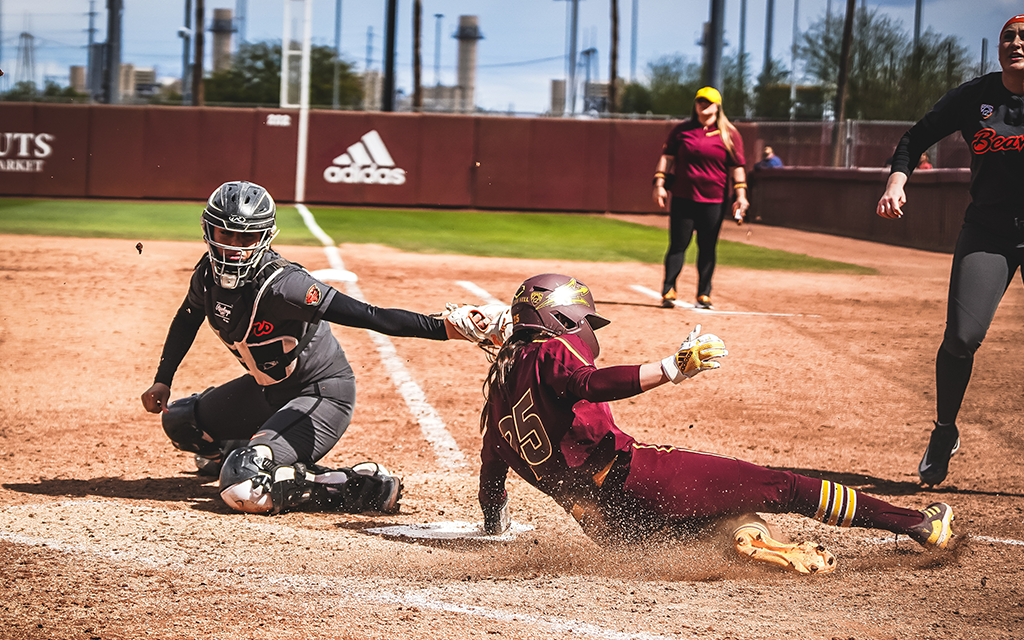
ASU softball’s success at stealing bases is giving them a chance to lead the Pac-12 in steals for the first time since 2006. (Photo courtesy of Sun Devil Athletics)
PHOENIX – The neon yellow ball, just released from the revolving arm of the pitcher, accelerates to the Arizona State batter at the plate. Then a whoosh of the bat. A pop in the glove. Strike out!
Success for the Oregon Ducks, except for the reveal at second base. An ASU player dashing from first base to second base. The catcher doesn’t even offer a throw, there is no chance to stop it. The player, Tanya Windle, just stole second base.
As expected no major celebration follows this tiny victory but jubilee is the result when Windle slides into home plate minutes later, morphing her slide into an immediate jolt upright and an indulgent celebration.
This season, stealing bases is an art form that Arizona State softball has painted beautifully. The Sun Devils’ 57 steals is the second highest in the Pac-12 and owns them a top-35 spot in the NCAA. It’s a stark contrast to last season, when the team ended the spring with 42 stolen bases, ranking it seventh in the Pac-12.
“We’ve told them a million times we’re going to build this ballclub to be able to win big games in big moments on the biggest stage,” coach Megan Bartlett said. “That’s the vision and that’s how we’re going to build it.”
The Sun Devils are 34 games into the season and averaging 1.73 steals a game. Compared to the same time last season, the team was recording just 0.97 steals a game. ASU isn’t just playing more aggressively on the base paths but also succeeding better than anyone in their conference. The team’s 57 steals on 64 attempts (89%) gives them the best success rate in the Pac-12.
Only looking at the team’s stealing prowess compared to last season would undercut what is special about what Arizona State is doing this season. Since 2010, the most steals accomplished by a Sun Devil softball squad is 62, a milestone this season’s team is five steals short of eclipsing. This year’s Sun Devils are on pace to reach 84 steals in the season.

Kayla Lissy’s base-stealing expertise highlights ASU softball’s strategic and aggressive approach to the game this season. (Photo courtesy of Sun Devil Athletics)
Stealing a base is an exciting moment in a ball game, a showcase of speed and timing, especially in softball where players can not lead off. On the flip side, a good way to spoil an impressive steal is to not turn it into a run. Luckily, ASU is turning their steals into numbers on the scoreboard. Out of the 57 steals this season, 30 have rounded into home. The chaos created on the base paths has led ASU to score 184 runs this season, third best in the Pac-12.
The question is why and why now? What has led ASU to go from a team that barely recorded a steal a game for the last decade to one that is stealing almost two bases a game?
An obvious first answer is Bartlett. The ASU coach is over halfway through her second season as the team’s head coach but as a player she was an expert in robbing bases, stealing 76 bases at Notre Dame. Stealing bases, Bartlett said, is ingrained in her philosophy.
She landed her first head coaching role at Ball State in 2015 and through her five seasons the team averaged less than a steal a game.
Bartlett’s introduction at ASU came after coach Trisha Ford departed for a head coaching job at Texas A&M. Following Ford was a tough task for the incoming coach, who had only eight players from Ford’s final season return. With just one of those players being a pitcher, Bartlett utilized the transfer portal to bring in eight players.
Bartlett admits that her first year was just about putting a team together. After six winning seasons under Ford, ASU went 22-26 overall in Bartlett’s debut season.
With another year to recruit and find players that match her scheme, Bartlett has assembled a team that is beginning to match her vision. This season her team is 18-15 overall and the success of her team is linked to what led to the increase in stealing bases.
“Last year, we honestly just didn’t have the personnel to execute it,” Bartlett said. “But now that we have a few more of our own kids, we’re able to execute at that scale. We’re gonna keep doing it.”
A glance at the ASU players contributing in stolen bases this season showcases the difference from last year. New additions to the team, freshmen and transfers, have created 34 of the 57 stolen bases this season.
The two players leading the way for the Sun Devils are Kayla Lissy and Yannixa Acuña. The duo are the only players on the team to exceed double-digit stolen bases this season. Lissy leads the team with 12 stolen bases and Acuña recorded 11 before a season-ending injury in March.
While both players were on the roster last season, their base-stealing was minimal. Acuña, a freshman last year, didn’t start in a single game but recorded four steals. As for Lissy, she was in her first season at ASU after transferring from Ball State where she stole 26 bases in two seasons. With ASU, the infielder stole just three bases despite starting in 37 games but attributes the lack of stealing to battling injuries.
Heading into this season, the desire to employ Lissy’s speed didn’t come from a coaching philosophy change. According to Lissy, it just happened.
“Last season I wasn’t the fastest and then this season I knew I had speed coming into it and I feel like the coaches noticed that as well,” Lissy said. “Once they started calling the steals and letting me do that I got used to it and just got the hang of being ready to go.”
Utility player Audrey LeClair is also making an impact on the base paths. The Phoenix native is in her first season at ASU following four seasons at Michigan where she racked up 24 steals. As a Sun Devil, LeClair is third on the team in steals with eight. Her skill at stealing bases was something she noticed the coaches highlighted in recruiting her.
“They definitely said that I was a speed kid and I think I showed my smarts when it came to stealing bases and taking extra bases,” LeClair said.
While both players have played a pivotal role in their stealing success, they both have different views on what is the ultimate factor that has led to their success.
“I feel like the first thing would be actually getting on [base],” said Lissy.
“I think it’s the trust from coach B [Bartlett] in sending us, taking the risk, and knowing that it might not work out but having that trust in me to get it done,” LeClair said.
Whatever the secret sauce is, both players share qualities that have allowed them to take extra bases this season. When Bartlett compares the two athletes, the words “super explosive”, “twitchy”, and “elite speed” are used. Both players get great jumps off of their initial base before making hard dives into the next base. The ability to dive instead of slide feet first is an asset on its own as a feet-first slide breaks up the runner’s momentum whereas a dive uses all the speed and power in the run.

ASU softball’s Audrey LeClair slides into home base for one of her 13 runs scored this season. (Photo courtesy of Sun Devil Athletics)
“They are literally exploding and driving at that base, full speed, and it also gives you a little bit of room to manipulate the finish, whether you’re gonna go straight in or grab the right side of the base and kind of swing your legs out,” Bartlett said.
The task of swiping bags isn’t just as simple as being speedy, although that is a major factor. Quickness, reaction, awareness, diving, sliding, all are part of a successful skillset. Analyzing pitchers’ and catchers’ timing, a catcher’s ability to throw to second or react quickly along with the physical skills of the runner all come together to make an art form to this ability.
Bartlett agrees there is an art to stealing bases, but like a singer who can naturally hear a note and sing it, some great players have an innate talent to steal bases.
“Really amazing base runners have the instincts to see the play unfold before it happens or see the pitch profile unfold before it happens,” Bartlett said. “They know exactly, probably on a subconscious level, how quickly they can get from point A to point B. And then they’ll start to make calculated judgments depending on how close of a play they think it’s going to be.”
Although the Sun Devils have stacked impressive stolen base numbers, it has not equated into wins in the Pac-12. The team’s 2-7 conference record reflects a downturn in stolen bases as well. In nine games the team has stolen seven bases, averaging just 0.78 per game.
It’s not unusual for teams to stall out in stealing bases once they get into conference play. Multiple factors such as less experimentation compared to earlier in the season and unfamiliarity with non-conference teams plays a part but Bartlett attributes it to the talent of the Pac-12 catchers. With proficient catchers behind the plate, the decision to attempt becomes more strategic and selective.
“You certainly have to try and pick the right count. If you can pick a changeup off the pitcher, that’s great, because when I know changeups are coming we’re going to take off,” Bartlett said.
“You have to assess the arm talent behind the plate quickly with an opposing team. Certainly that gets tough when everybody gets into conference (play). There’s certainly a bit of an art to it.”
Arizona State has 16 more games before the Pac-12 tournament so what comes next this season is still up in the air. What is clear is that Bartlett is forming the identity of her team and teams to come. One aspect of that identity is creating chaos on the base paths. In her second season, Bartlett has provided a game plan that has found success but what comes next relies on the players investing in her philosophy.
“Once the players understand the system and why it’s important, not just to put pressure on the opposing pitcher, but how it affects us mathematically to keep our run total up, it’s fun because then they start to make their own kind of calculated risks on the bases,” Bartlett said.
